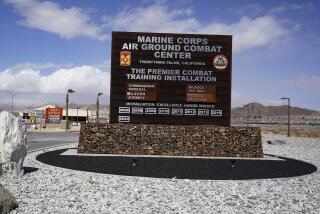‘Almost Miracle’ That U.S. Soldier Survived Blast
- Share via
ZUPANJA, Croatia — By all accounts, the first U.S. casualty of the peacekeeping mission in the Balkans is lucky to be alive.
The wounded soldier, Spc. Martin John Begosh, 23, of Rockville, Md., was recovering Sunday at a U.S. mobile military hospital near here after his Humvee hit a land mine a day earlier while he was on patrol in northern Bosnia-Herzegovina.
“It could have been a lot worse,” one military expert who examined the site said Sunday. “It’s almost a miracle that he survived.”
On Saturday, Begosh, a military police officer, was assigned to a routine mission. He was driving in a convoy along the disputed Posavina Corridor, accompanying members of the Army’s psychological operations team who were alerting residents that U.S. soldiers would be arriving soon. Because the lead vehicle had gotten a flat tire, Begosh drove first in line.
After driving on main roads, the convoy headed down a narrow, muddy track. The brush was dense. Clearly, the path was hardly used. Yet there it was on the map--a road that looked like a secondary route but that turned out to be scarcely better than a jeep trail.
“We got lost,” said Sgt. T. Avallone, a 32-year-old New York native in another vehicle.
Spc. Adam Seegraves, who was also in the convoy, told Associated Press that the vehicles ended up on the muddy route after their unit leader consulted the maps “that made it look like a major road.” The group also checked their computerized satellite positioning devices in an effort to better understand their location, Seegraves said.
“But I knew right away something was wrong,” Seegraves said. “It was overgrown with vegetation and all gutted out. I don’t know why we didn’t turn back right then.”
When they came to a Bosnian Serb checkpoint, several Serbian soldiers came out and tried to warn the Americans not to travel farther, the soldiers told The Times, speaking through an interpreter.
“The guys tried to warn them, tried to stop them, but the Americans didn’t want to stop, they didn’t want to believe them,” one Serb said.
But some of the Americans say they simply didn’t understand the Serbs--it wasn’t that they didn’t believe them.
Begosh’s vehicle moved on. Suddenly, there was an explosion. “We thought it was a mortar attack,” Avallone said.
Spc. Ray Baney sat in the passenger seat next to Begosh. “I knew we hit a mine. I could think only one thing: death,” said Baney, a 28-year-old Florida native.
Baney said it seemed like the Humvee was shoved up in the air and then thumped back down to the ground. When he looked over at Begosh, “he was hanging under the truck, moaning and cussing.”
The Humvee had hit a powerful antitank mine. The explosion blew out the front portion of the Humvee, blackening snow around the twisted, crippled vehicle.
Later, the Serbian soldiers examined the area around the twisted metal remains of the Humvee and found four other antitank mines.
Begosh, who received a Purple Heart, on Sunday was recovering from four hours of surgery to set a broken bone in his right leg, place three pins in his right foot and remove shrapnel from his left leg.
Asked if he wanted to call his parents in Maryland, where it was six hours earlier, Begosh replied: “Sure. Oh, wait a minute, what time is it?”
Assured that they would want to hear from him even if it meant an early morning call, Begosh phoned his parents and said, “Hey, what’s going on?”
More to Read
Sign up for Essential California
The most important California stories and recommendations in your inbox every morning.
You may occasionally receive promotional content from the Los Angeles Times.













